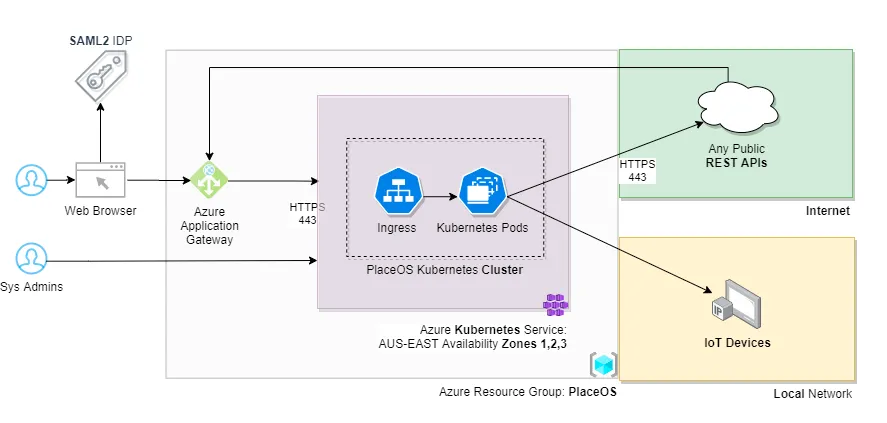System Architecture
System Architecture
Section titled “System Architecture”Service Architecture
Section titled “Service Architecture”High level network diagram of an implementation orchestrated via Kubernetes on Azure

Microservices running in PlaceOS Kubernetes Cluster
Section titled “Microservices running in PlaceOS Kubernetes Cluster ”
ingress
Section titled “ingress”Serves web requests (static files and upstream reverse proxying to the API service).
See the Docker Image and Source on GitHub.
Distributed key-value store used for PlaceOS service discovery and leader election.
See the Docker Image and Source on GitHub.
postgresql
Section titled “postgresql”Database for permanent storage of PlaceOS configuration. Configuration: Three node cluster in 3 different availability zones within same region for HA.
See the Docker Image and Source on GitHub.
Application in a Docker container that interfaces with external devices/services.
See the Docker Image and Source on GitHub.
Application in a Docker container that provides authentication.
See the Docker Image and Source on GitHub.
rest-api
Section titled “rest-api”Application in a Docker container that provides REST API for web applications.
See the Docker Image and Source on GitHub.
triggers
Section titled “triggers”Perform user defined actions, without code, under certain conditions.
See the Docker Image and Source on GitHub.
dispatch
Section titled “dispatch”Reverse proxy incoming communications from devices/services to PlaceOS core. This is required to handle protocols like SNMP - often not required.
See the Docker Image and Source on GitHub.
High Availability and Distributed Control
Section titled “High Availability and Distributed Control ”High availability works by distributing services through Availability Zones. For platforms like AWS Fargate, containers are initially automatically distributed. If a zone becomes unavailable, containers are re-launched in an alternative Availability Zone.
Components
Section titled “Components”Drivers exist as files inside the PlaceOS core containers. PlaceOS Core creates a separate process for each Driver in use. This will serve all the Modules (instances) of this Driver.
Modules are instances of a Driver, that represent a single real-world device/service. They are distributed among the instances of core and exist in memory of the PlaceOS core containers. Modules reflect their runtime state in Redis, making it available for other components of the system
The PlaceOS Backoffice web application manages them both via PlaceOS REST-API. It updates module configuration via PostgresQL.
Service Discovery
Section titled “Service Discovery”Instances of PlaceOS Core advertise their existence to an etcd cluster as they come online. They also query etcd to discover other active instances. Each service continues to advertise it’s existence with the short TTL while it’s are online. If a service is offline, etcd will automatically remove it’s entry after the TTL expires. Interested services are made aware of any changes to the cluster so they can rebalance.
Distribution of Modules across Cores
Section titled “Distribution of Modules across Cores ”Rendezvous hashing determines the module distribution across active instances of PlaceOS Cores. It also alters the distribution when a core goes online or offline. All Cores will push runtime Module state to Redis where other components can access it. That state can persist the availability of the Core.

